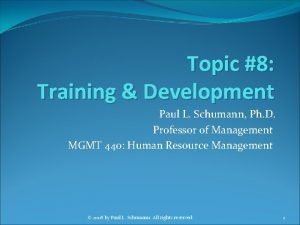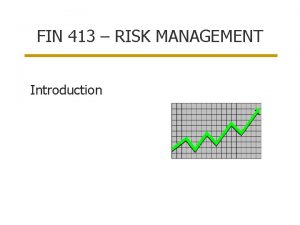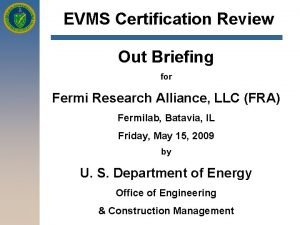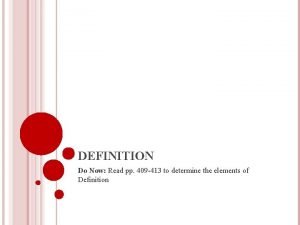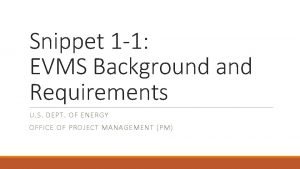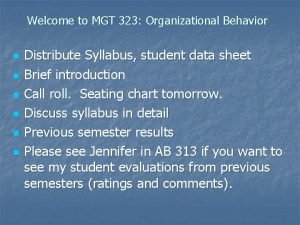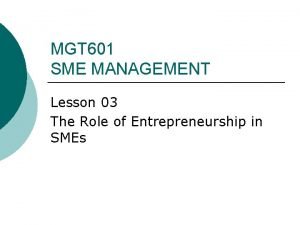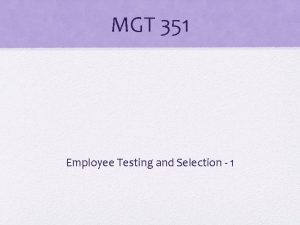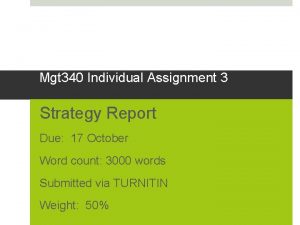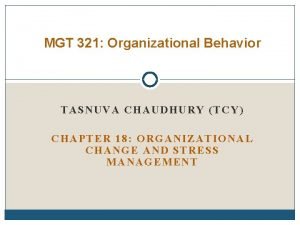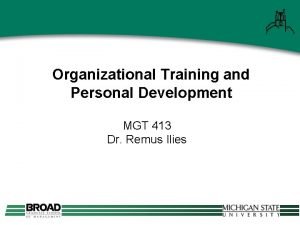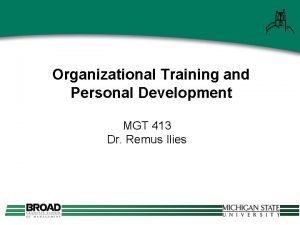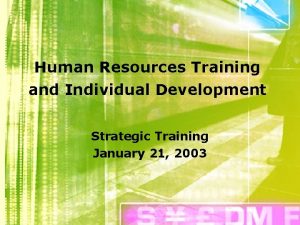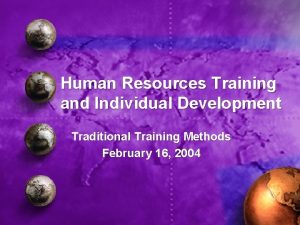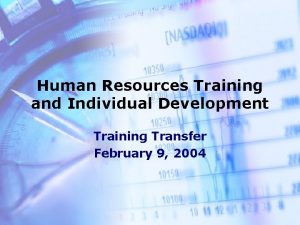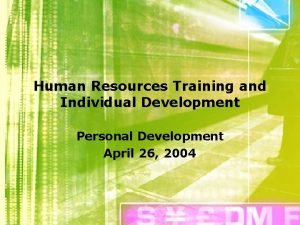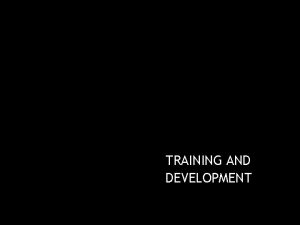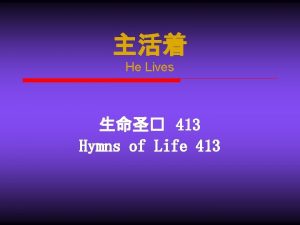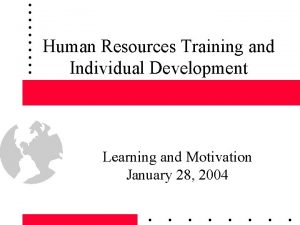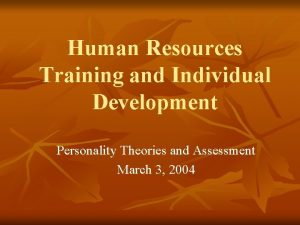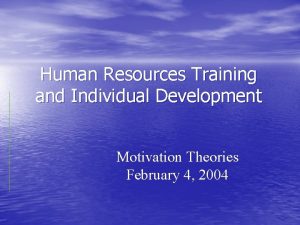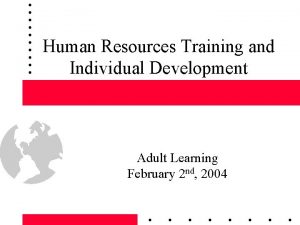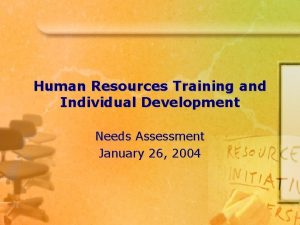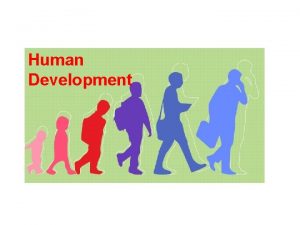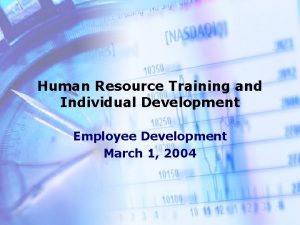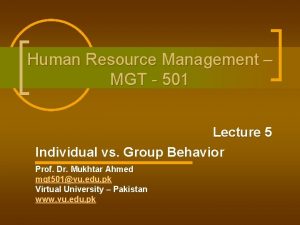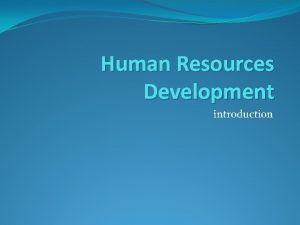MGT 413 Human Resources Training and Individual Development






















- Slides: 22

MGT 413: Human Resources Training and Individual Development Happiness and Well-Being April 21, 2004

Outline • • • Happiness and life satisfaction Job satisfaction Stress Increasing happiness Myers Video Exercise: Balancing Your Life (? )

Attitudes • Happiness – Percent time happy – Your subjective assessment of how happy you are in general • Life satisfaction – In most ways my life is close to ideal • Career satisfaction – I am satisfied with the progress I have made toward meeting my overall career goals • Job Satisfaction – I like my job

Happiness • Happiness – Subjective Well-Being (SWB) • Both cognitive and affective components • Why is happiness important? • Role of affect

Happiness Some Things You May Not Know • Money has little effect on happiness (r=. 13) • Winning the lottery has little effect on happiness • Happiness is partly innate • Happy people live longer • Happiness has not increased over time • Demographics are unrelated to happiness • Having children does not increase happiness • People, not events, determine happiness

Job Satisfaction • Average level of overall job satisfaction in organizations – 70 -80% • However, there is wide variation within specific facets of job satisfaction – Generally high: work, co-workers, supervisor – Generally low: pay, promotion opportunities

Average Job Satisfaction Does Pay Satisfy? Average Earnings

Predictors of Job Satisfaction Source: 55 Executive MBA Students at UF

Importance of Work Itself Source: 55 Executive MBA Students at UF

Implications • Prepare yourself for career that interests you; within a career field, choose job based on intrinsic interest • Dimensions of intrinsic interest – – – Skill variety Task significance Task identity Autonomy Feedback

Stress • A patterned physiological and emotional response to any event that: – Is physically or psychologically demanding, and – Causes uncertainty or perceived lack of control • These events are termed “stressors” • Stress can be “chronic” or “acute” • The physical and emotional responses to stress are termed “strain” – Deviations from normal states of human functioning resulting from exposure to stressful events.

A Model of Stress

Is Stress Bad? • Most jobs function effectively with a moderate level of stress – Too little stress boredom – Too much stress exhaustion – Moderate stress job challenge

Life Stressors • • • • Death of spouse=100 Divorce=73 Separation=65 Detention=63 Major injury/illness=53 Marriage=50 Fired=47 Reconciliation=45 Retirement=45 Pregnancy=40 Sexual difficulties=39 New family member=39 Business readjustment=39 • • • Child leaving home=29 In-law trouble=29 Boss trouble=23 Change in residence=20 Change to new school=20 Change in church=20 Mortgage=17 Change in sleep=16 Vacation=13 Christmas=12 Minor violations=11

Attitude Correlates of Stress Life satisfaction Job stress -. 34 Career satisfaction -. 34 -. 58 Work family conflict . 02 . 50 Family work conflict . 31 . 49 Depression . 37 . 79 Happiness -. 18 -. 58 -. 70

Job Stressors • • Task Demands Physical Conditions Information Overload Organizational change

Role Stressors • Role Conflict – The demands of one job role are not compatible with the demands of some other job role • Role Ambiguity – The expected behaviors for a given role are unknown or uncertain

Work-Family Conflict • Work family conflict – After work, I come home too tired to do some of the things I’d like to do • Family work conflict – My personal life takes up time that I’d like to spend at work

Consequences • Strain – Burnout – Depressed mood, anxiety – Physical health (sleeping, heart problems, etc. )

Individual Factors • Not everyone reacts to stressors in the same way. Some individuals cope better: – Hardiness • Characterized by good mental and physical health, which allows one to cope with stress • Others individuals cope worse: – Negative affectivity – Type A Behavior Pattern • Characterized by extreme competitiveness, impatience, aggressiveness, and work devotion • Role of social support

What Can You Do?

Increasing Happiness • Top-down • Bottom up – Cognitive approach • Happy people, compared to unhappy: take a positive view, have realistic goals, see the funny side in things, do not blame themselves, believe they control what happens, depend on themselves – Behavioral approach • Enhance positive affect: exercise, social activities • “Mood in Everyday Life” • “The Pursuit of Happiness”
 Training design example
Training design example Fin 413
Fin 413 Why evms certification
Why evms certification Cs 413 bilkent
Cs 413 bilkent Hino 413
Hino 413 What does 413 mean
What does 413 mean 452 en yakın yüzlüğe yuvarlama
452 en yakın yüzlüğe yuvarlama Slidetodoc.com
Slidetodoc.com A 413
A 413 Doe 413 evms
Doe 413 evms Human needs and human development chapter 8
Human needs and human development chapter 8 Chapter 8 human needs and human development
Chapter 8 human needs and human development Transformation processes
Transformation processes Variable resources definition
Variable resources definition Gni definition ap human geography
Gni definition ap human geography Individual resource
Individual resource Renewable vs nonrenewable resources worksheet
Renewable vs nonrenewable resources worksheet Mgt 323
Mgt 323 Scope of accounting
Scope of accounting Mgt 601
Mgt 601 Mgt 351 nsu course outline
Mgt 351 nsu course outline Mgt 340 assignment
Mgt 340 assignment Mgt321
Mgt321
